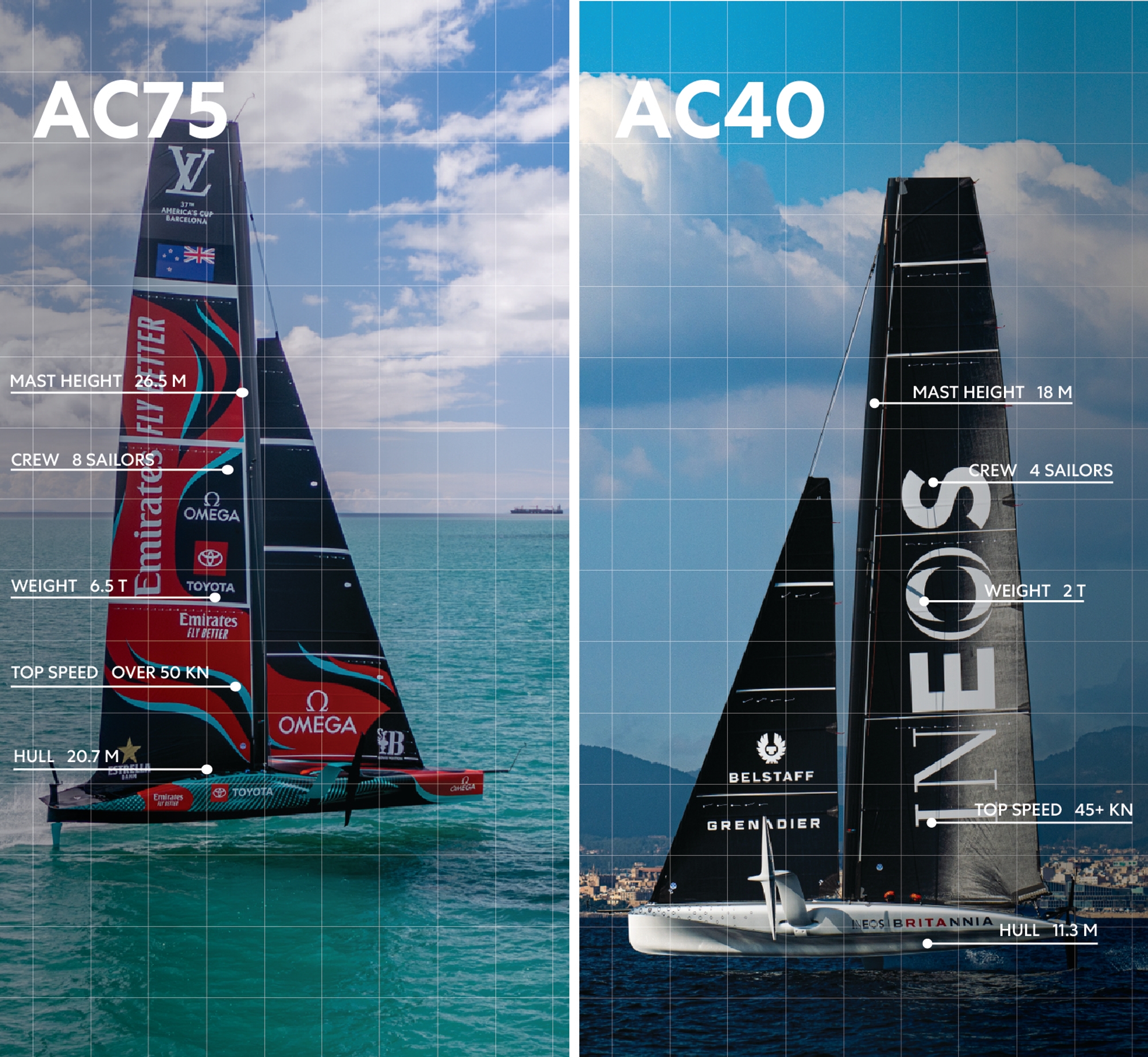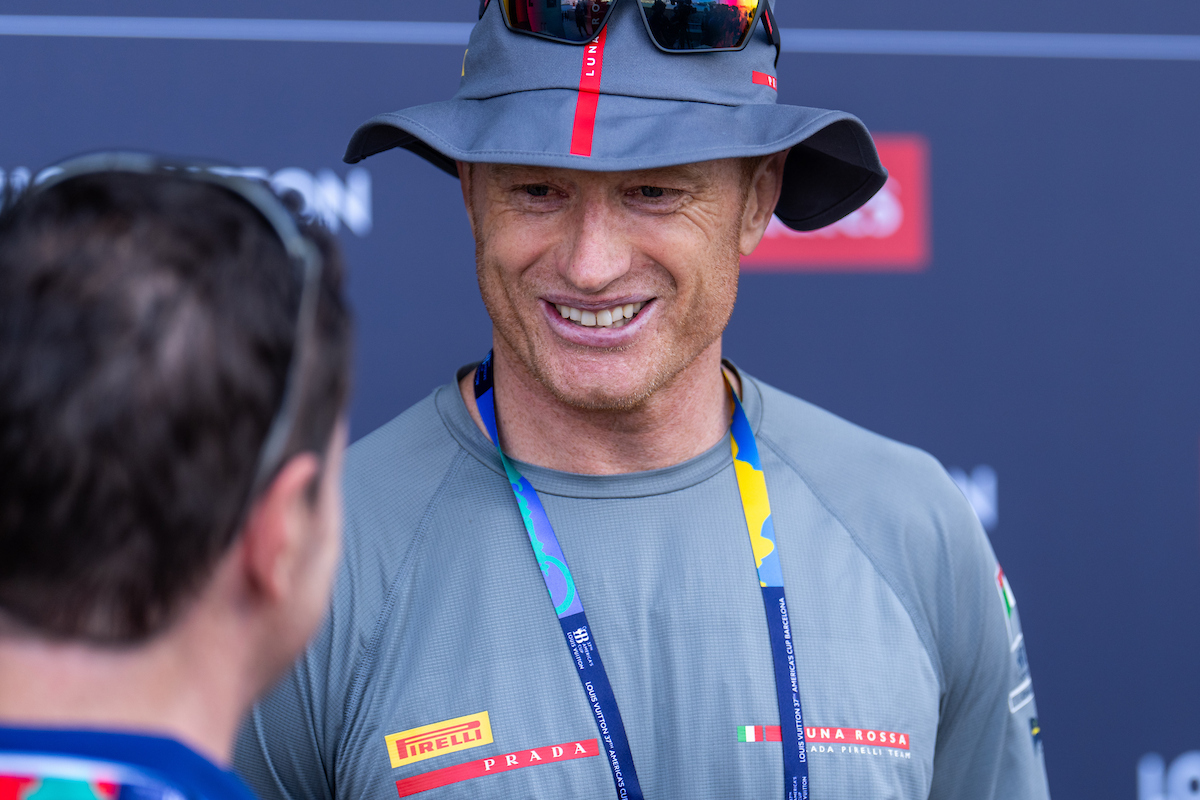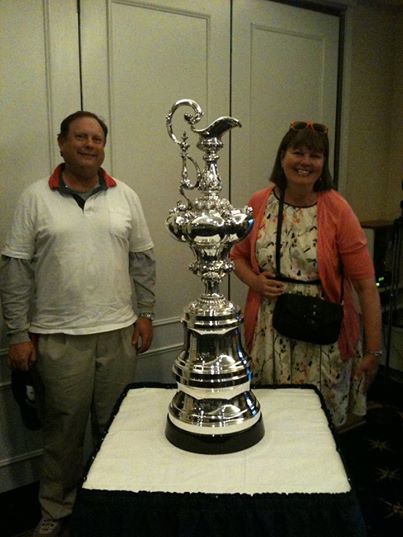Not only are Team New Zealand the most successful America’s Cup team in modern history; when it comes to match racing on foils they are unrivalled. What features of the New Zealand team and boat are different from non foiling America’s Cup boats and how was the team changed to take advantage of those features. Is the America’s Cup being held In Barcelona?
The America’s Cup is indeed being held in Barcelona, Spain in 202412. The 37th edition of this prestigious sailing competition will take place from August to October 2024, with the Louis Vuitton America’s Cup Match starting on October 12, 20241.
Team New Zealand’s Dominance in Foiling
Emirates Team New Zealand has established itself as the most successful America’s Cup team in modern history, particularly when it comes to match racing on foils.

Their dominance can be attributed to several key factors:
Foiling Technology
The introduction of foiling technology has revolutionized America’s Cup racing, and Team New Zealand has been at the forefront of this innovation. Foiling allows the boats to lift out of the water, reducing drag and dramatically increasing speed. Some key features that distinguish foiling America’s Cup boats from traditional non-foiling vessels include:
- Hydrofoils: These wing-like structures underneath the hull allow the boat to lift out of the water at high speeds.
- Complex control systems: Foiling requires sophisticated hydraulic and electronic systems to manage the foils and maintain stability.
- Lighter construction: Foiling boats are typically built with lighter materials to maximize speed and maneuverability.

The AC75s are the pinnacle of foiling monohull yachts. Created for the 36th America’s Cup, they are a technological leap ahead of typical yachts as Formula 1 is to your daily driver. With foils that lift them out of the water and enable the yachts to generate so much momentum that they sail 4x faster than the wind.
For the Louis Vuitton 37th America’s Cup, the second generation of the AC75s will be even faster with wider foils and refinements all over. Eight crew will be aboard and some of the finest sailing talent will be charged with racing them.
The AC40s, meanwhile, are the boats used for the UniCredit Youth and Puig Women’s America’s Cup events and as training vessels for the main teams competing in the Louis Vuitton 37th America’s Cup. Smaller but no less potent, with a four-person crew, these pocket-rockets were launched to much fanfare in September 2022, and their performance has been astonishing.
Team Adaptation
To take advantage of foiling technology, Team New Zealand has made several changes to their team structure and approach:
- Multidisciplinary expertise: The team now includes not just sailors but also aerodynamicists, hydraulic specialists, and control system engineers.
- Enhanced physical training: Crew members require exceptional strength, agility, and reflexes to handle the high-speed, high-G-force environment of foiling boats.
- Simulator training: Extensive use of simulators allows the team to practice and refine their techniques in various conditions.
- Data-driven approach: Advanced telemetry and analytics are used to optimize performance and strategy.
Design Innovation
Team New Zealand has consistently pushed the boundaries of boat design, often introducing revolutionary concepts that give them a competitive edge. Their ability to innovate within the rules of the competition has been a key factor in their success.
Barcelona as the Host City
The choice of Barcelona as the host city for the 37th America’s Cup adds an exciting dimension to the competition. The Catalan capital was selected for several reasons:
- World-class facilities: Barcelona’s Port Vell area will house all the team bases and the America’s Cup Race Village1.
- Ideal racing conditions: The waters off Barcelona’s coast provide excellent conditions for high-performance sailing.
- Spectator-friendly venue: The race course is set just outside the port entrance, allowing for significant fan zones and viewing platforms1.
- Rich sailing heritage: Barcelona has a strong maritime tradition and has previously hosted major sailing events.
- Global appeal: As one of the most visited cities in the world, Barcelona offers a stunning backdrop for this prestigious event13.
- The economic support of the Government of Spain, the Generalitat de Catalunya and the Barcelona City Council, as well as the Diputació de Barcelona and Turisme de Barcelona, plus the endorsement of Barcelona Global, which has promoted and designed the candidacy, were other aspects that tipped the balance in favor of Barcelona.

The 37th America’s Cup in Barcelona promises to be an exciting showcase of cutting-edge sailing technology and world-class competition, with Team New Zealand looking to defend their title against a field of highly competitive challengers.
Foiling
The introduction of foiling technology in sailing has significantly changed the techniques used by sailors, particularly in high-performance racing like the America’s Cup.

Here are the key differences in sailing techniques between foiling and non-foiling boats:
Speed and Acceleration
Foiling boats:
- Require precise control to initiate and maintain foiling
- Experience rapid acceleration once foiling begins
- Can reach speeds up to double the wind speed3
Non-foiling boats:
- Have more gradual acceleration
- Speed is typically limited by hull speed or planing capabilities
Balance and Stability
Foiling boats:
- Demand constant adjustments to maintain balance on foils
- Require crew to manage pitch and roll more actively
- Often use complex control systems to assist with stability1
Non-foiling boats:
- Generally more stable, especially in displacement mode
- Rely more on hull shape and weight distribution for stability
Sail Trim and Power Management
Foiling boats:
- Focus on generating enough power to initiate foiling
- Once foiling, sail trim is adjusted to maintain optimal speed and height
- Power management is critical to prevent nosedives or crashes
Non-foiling boats:
- Sail trim is more focused on maximizing efficiency through the water
- Power management is important but less critical for safety
Steering and Course Corrections
Foiling boats:
- Require more subtle and frequent steering inputs
- Turns and maneuvers must be executed with precision to maintain foiling
- Course corrections can have a more dramatic effect on speed and stability
Non-foiling boats:
- Allow for more forgiving steering inputs
- Maneuvers are generally slower and more predictable
Crew Work and Positioning
Foiling boats:
- Crew positioning is crucial for maintaining foil balance
- Require quick and coordinated movements during maneuvers
- Often involve more physical demands due to higher speeds and forces1
Non-foiling boats:
- Crew positioning is important but less critical for moment-to-moment performance
- Maneuvers are generally less physically demanding
Use of Technology

Hydrofoil boats, marvels of modern engineering, glide above the water surface at high speeds with minimal drag. Yet, their interaction with floating debris like logs and branches is of primary concern. While conventional boats often face significant damage from such impacts, hydrofoil vessels employ advanced safety systems to mitigate these risks.
Foiling boats:
- Rely heavily on advanced sensors and control systems
- Often incorporate hydraulic systems for foil and sail adjustments
- Require crews to interpret and react to complex data inputs
Non-foiling boats:
- May use technology, but it’s generally less critical to performance
- Rely more on traditional sailing skills and intuition
Tactical Considerations
Foiling boats:
- Tactics often revolve around maintaining foiling conditions
- Course selection may prioritize areas with steady wind to keep foiling
- Laylines and mark roundings require earlier preparation due to higher speeds
Non-foiling boats:
- Tactics focus more on traditional factors like wind shifts and current
- Course selection is more flexible, allowing for tighter maneuvers
Safety Considerations
Foiling boats:
- Higher risk of injury due to increased speeds and potential for sudden crashes
- Require additional safety gear and protocols
- Demand a higher level of skill and experience from the crew1
Non-foiling boats:
- Generally safer at lower speeds
- More forgiving of crew errors
- Easier for less experienced sailors to handle
In summary, sailing foiling boats requires a different set of skills and techniques compared to traditional sailing. The focus shifts from maximizing efficiency through the water to managing the complex balance of forces required to maintain flight on foils. This demands not only advanced technical skills but also quick decision-making, precise control, and a deep understanding of the boat’s behavior in various conditions.
Foiling boats handle different weather conditions compared to non-foiling boats
Foiling boats handle different weather conditions quite differently compared to non-foiling boats, with both advantages and challenges. Here’s a breakdown of how foiling boats perform in various conditions:
Wind Conditions
Light Winds:
- Foiling boats can often outperform traditional boats in light winds
- They require less wind to get “up on foils” and achieve high speeds
- However, they need a minimum wind speed to generate enough lift for foiling
Moderate Winds:
- This is where foiling boats excel, achieving much higher speeds than traditional boats
- They can maintain foiling in a wider range of wind conditions once airborne
Strong Winds:
- Foiling boats can handle strong winds well when properly controlled
- They may actually be more stable than traditional boats in choppy conditions
- However, they require highly skilled crew to manage the increased forces and maintain control
Sea State
Flat Water:
- Ideal conditions for foiling boats
- They can achieve maximum efficiency and speed
- Easier to maintain stable flight
Small Chop:
- Foiling boats can handle small chop better than traditional boats
- They “fly” above the waves, reducing the impact of surface chop
- This results in a smoother ride for crew and potentially higher speeds
Large Waves:
- Foiling boats face challenges in large waves
- They may need to “land” and operate as a traditional hull in very rough conditions
- Risk of sudden impacts if foils breach the water surface
Ocean Swells:
- Foiling boats can navigate ocean swells, but it requires advanced control systems and skilled helming
- They may need to adjust foil angles constantly to maintain stability
Specific Weather Phenomena
Gusty Conditions:
- Foiling boats are more sensitive to wind gusts
- Sudden changes in wind speed can affect lift and stability
- Requires quick reactions from crew to maintain control
Rain:
- Generally less affected by rain than traditional boats
- Reduced water friction means less impact from rain on the water surface
Fog:
- Similar challenges to traditional boats in terms of visibility
- May need to reduce speed more drastically due to higher operating speeds
Temperature Effects
Cold Water:
- Foiling boats may perform slightly better in colder, denser water
- Increased water density can provide more lift to the foils
Warm Water:
- Slightly reduced performance due to lower water density
- May require minor adjustments to foil angles
Handling Obstacles
Foiling boats face unique challenges when it comes to obstacles:
- They are more vulnerable to submerged objects due to their foils
- Collision with floating debris can be more dangerous at high speeds
- Advanced detection systems are often employed to mitigate these risks3
Stability and Comfort
- In moderate conditions, foiling boats can provide a smoother ride by flying above the waves
- However, they are generally less stable at low speeds or when not foiling
- Sudden changes in conditions can lead to abrupt movements, requiring crew to be more alert
Adaptability
Modern foiling boats, especially in competitive sailing, have developed systems to adapt to changing conditions:
- Adjustable foil angles allow for optimization in different wind and wave states
- Some designs incorporate retractable or folding foils for versatility2
In summary, foiling boats offer superior performance in many conditions, particularly in moderate winds and relatively calm seas. However, they require more skill to handle, are more sensitive to extreme conditions, and face unique challenges in very rough weather or around obstacles. The choice between a foiling and non-foiling boat depends on the intended use, sailing conditions, and skill level of the crew.
Jimmy Spithill

Spithill is best known for twice winning the America’s Cup with Oracle Team USA in 2010 and 2013, including the epic comeback at San Francisco, where the American-based crew was down 8-1 at matchpoint, before winning eight straight races against the Kiwi.
Jimmy Spithill has made eight consecutive America’s Cup attempts throughout his career.

Here’s a detailed list of his America’s Cup campaigns:
- 2000: Young Australia
- Yacht Club: Cruising Yacht Club of Australia
- Boat: AUS 31 (an older generation boat)
- Result: Eliminated in Louis Vuitton Cup round robins
- 2003: OneWorld Challenge
- Yacht Club: Seattle Yacht Club
- Boat: USA-67
- Result: Reached Louis Vuitton Cup semifinals
- 2007: Luna Rossa Challenge
- Yacht Club: Yacht Club Italiano
- Boat: ITA-94
- Result: Reached Louis Vuitton Cup final, lost to Emirates Team New Zealand
- 2010: BMW Oracle Racing
- Yacht Club: Golden Gate Yacht Club
- Boat: USA 17 (90-foot trimaran with a wing sail)
- Result: Won the America’s Cup
- 2013: Oracle Team USA
- Yacht Club: Golden Gate Yacht Club
- Boat: AC72 catamaran
- Result: Defended the America’s Cup with a comeback from 8-1 down
- 2017: Oracle Team USA
- Yacht Club: Golden Gate Yacht Club
- Boat: AC50 catamaran
- Result: Lost the America’s Cup to Emirates Team New Zealand
- 2021: Luna Rossa Prada Pirelli
- Yacht Club: Circolo della Vela Sicilia
- Boat: AC75 foiling monohull
- Result: Won the Prada Cup, lost in America’s Cup final to Team New Zealand
- 2024: Luna Rossa Prada Pirelli
- Yacht Club: Circolo della Vela Sicilia
- Boat: AC75 foiling monohull
- Result: Lost in the Louis Vuitton Cup final to INEOS Britannia

Spithill burst onto the America’s Cup scene in 2000 with Young Australia, showing his precocious talent despite his team’s antiquated boat. At the age of 20, he was the youngest helmsman in the America’s Cup and earned his nickname ‘Pitbull’ with his trademark aggressive style. He followed this with a Semifinal performance with OneWorld in 2003
Adaptations for different boat types:
Jimmy Spithill has shown remarkable adaptability throughout his America’s Cup career, transitioning from traditional monohulls to multihulls and then to foiling boats. He has had to develop new skills for each boat type:
- For multihulls (2010, 2013, 2017): Spithill had to adapt to much higher speeds and the unique handling characteristics of catamarans. He developed skills in managing apparent wind sailing and the more physical aspects of multihull racing.
- For foiling boats (2021, 2024): Spithill had to learn to “fly” the boat, maintaining a delicate balance to keep the boat on its foils. This required developing a feel for the boat’s attitude and making constant small adjustments.
- Co-helm system (2021, 2024): In the last two campaigns with Luna Rossa, Spithill adapted to a unique co-helm system, where he shared steering duties with Francesco Bruni, each responsible for different tacks.
Other sailing events:
Yes, Jimmy Spithill races in other sailing events. He has competed in:
- Sydney to Hobart Yacht Race: He skippered LDV Comanche to line honors victory in 2017.
- SailGP: He led the United States SailGP team and is planning to launch an Italian team in the league.
- RC44 Championship Tour: He has competed in this one-design keelboat circuit.
Age:
Jimmy Spithill was born on June 28, 1979, which makes him 45 years old as of October 202413.It’s worth noting that after the 2024 America’s Cup, Spithill hinted at retirement from America’s Cup racing, stating, “I think it’s time the gloves are hung up,” suggesting this might have been his last America’s Cup campaign4.
Based on the recent search results and Jimmy Spithill’s comments, we can infer his thoughts on the future of sailing:
- Passing the torch to younger talent:
Spithill, at 45 years old, has expressed that he believes he’s “at the end of the line now” in terms of America’s Cup racing1. He acknowledges the rising young sailing talents, stating, “When I look at the talent — especially in Italy, but also worldwide — that is coming through. They are at a much better level than I ever was”1. This suggests he sees a bright future for sailing with new generations taking the lead. - Technological advancements:
Spithill has always been at the forefront of sailing technology. He emphasized the importance of simulators in modern America’s Cup campaigns, noting that not having one in 2017 was a significant disadvantage2. This indicates he believes the future of sailing will continue to be heavily influenced by technological innovations. - Globalization of sailing:
Spithill’s involvement in SailGP and his plans to launch an Italian team in the league3show his belief in the growing global appeal of high-performance sailing events beyond the America’s Cup. - Continued growth of the America’s Cup:
Despite retiring from America’s Cup racing, Spithill believes the event will continue to grow. Regarding the 37th America’s Cup in Barcelona, he stated, “I think this one will be very, very big”3, indicating his optimism about the future of the event. - Importance of venue and accessibility:
Spithill’s comments on the move of the America’s Cup to Barcelona highlight his awareness of the importance of venue choice for the sport’s growth and accessibility3. - Evolving boat designs:
Throughout his career, Spithill has adapted to various boat types, from traditional monohulls to foiling catamarans and now foiling monohulls. This evolution suggests he sees the future of sailing continuing to push the boundaries of boat design and performance.
In summary, while Spithill may be stepping back from America’s Cup racing, his comments suggest he sees a future for sailing that is technologically advanced, globally appealing, and driven by new talent, with events like the America’s Cup continuing to grow and evolve.